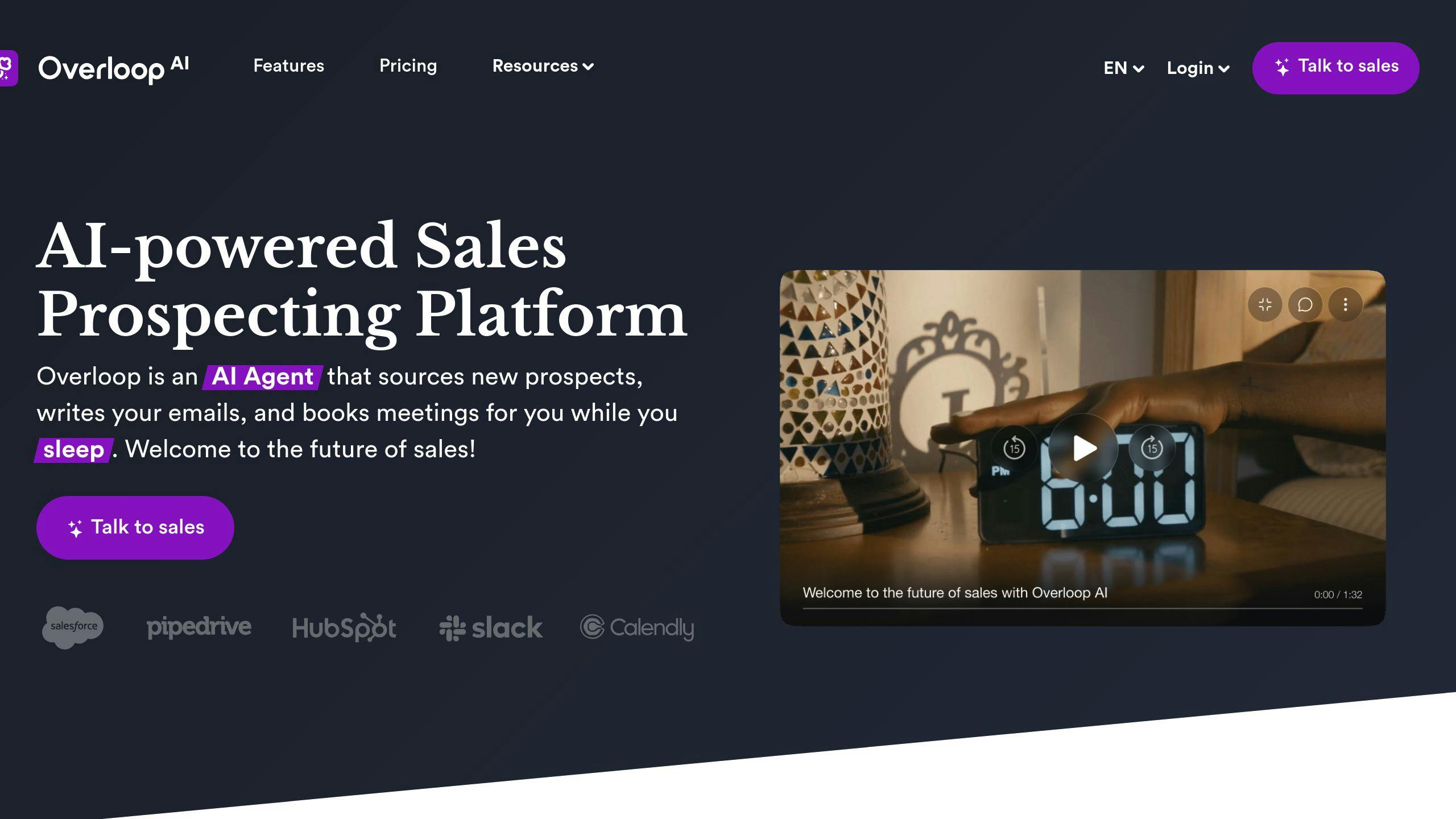In sales, cold leads are untapped opportunities that can grow your business - but they require a smart approach. This guide simplifies the process of turning cold leads into meetings using modern tools and strategies. Here's what you'll learn:
- Key Challenges: Low engagement, time-intensive prospecting, and limited trust.
- Solutions:
- Use AI tools like Cognism and Overloop to automate lead sourcing and outreach.
- Personalize messages with specific pain points and relevant solutions.
- Follow up consistently using tools like noCRM.io or Snov.io.
- Outreach Tips:
- Combine email, LinkedIn, and phone for better response rates.
- Test and refine campaigns by tracking open, response, and conversion rates.
- Balance Automation & Personalization: Let AI handle repetitive tasks while focusing on meaningful human interactions.
How I Effortlessly Book Meetings Through Cold Calls
Understanding Cold Leads and Their Potential
Defining Cold Leads
Cold leads are potential customers who have little to no prior knowledge of your business or its offerings. Unlike warm leads - who might have shown interest by visiting your website or downloading content - cold leads require more effort and a well-thought-out approach to guide them through the sales funnel.
Challenges in Working with Cold Leads
Engaging cold leads isn't easy. Sales teams often face several obstacles, including:
| Challenge | Impact | Solution Approach |
|---|---|---|
| Low Engagement Rates | Fewer conversion opportunities | Use personalized outreach informed by in-depth research and targeted strategies. |
| Time-Intensive Prospecting | Reduced productivity for the sales team | Automate processes with AI-powered tools to save time and resources. |
| Limited Initial Trust | Harder to secure meetings or interest | Establish credibility using tailored content and social proof. |
While these challenges can be daunting, they are not insurmountable. With the right tools and techniques, cold leads can be effectively converted into paying customers.
Opportunities in Managing Cold Leads
Cold leads hold untapped potential for business growth. For instance, personalized emails are 22% more likely to be opened, underscoring the importance of tailored communication [1].
AI-powered tools like Cognism and Kaspr are game-changers in this space. They simplify the process of identifying and reaching out to cold leads by offering features such as:
- Improved data accuracy and better targeting: These platforms automatically enrich contact details, helping sales teams focus on the right decision-makers.
- Scalable personalized outreach: They allow teams to send customized messages at scale while tracking engagement to refine strategies.
The secret to converting cold leads lies in combining automation with a personal touch. AI tools make the process efficient, but adding thoughtful, tailored messages and consistent follow-ups can significantly improve engagement rates [1][3]. By focusing on strategic communication and delivering value, businesses can turn cold leads into long-term customers.
Steps to Turn Cold Leads into Meetings
Finding and Researching the Right Prospects
AI tools like Cognism and ZoomInfo can help sales teams pinpoint decision-makers who align with their ideal customer profile. Here's how you can organize your research:
| Research Area | Key Elements to Consider | Tools for Research |
|---|---|---|
| Company Profile | Size, Industry, Revenue | ZoomInfo, LinkedIn Sales Navigator |
| Decision Makers | Role, Authority Level, Buying Power | Cognism, Seamless.ai |
| Business Challenges | Pain Points, Growth Goals, Market Position | Company Website, Industry Reports |
LinkedIn Sales Navigator is especially helpful for digging into prospects' backgrounds and identifying their key initiatives. These insights set the stage for outreach that directly addresses their needs.
Creating Personalized Outreach
Personalization goes far beyond just inserting a name into a generic message. To make your outreach stand out:
- Mention specific challenges the company is facing, based on your research.
- Bring up relevant industry news or events to show you're informed.
- Clearly connect your solution to their business goals.
- Include examples of how similar companies have benefited from your offering.
For instance, if you're reaching out to IT leaders, you might reference recent cybersecurity issues in their field and explain how your solution can tackle these problems effectively [1]. Of course, even the most well-crafted message won't work without consistent follow-ups.
Following Up to Keep Prospects Engaged
Following up is crucial for staying on your prospect's radar. Tools like noCRM.io can help you manage follow-up tasks and measure their impact [3].
Keep your follow-ups valuable by sharing resources like industry reports, case studies, or tailored demos. Using a mix of communication channels - email, phone, LinkedIn - can improve your chances of connecting while accommodating the prospect's preferences [2].
To refine your approach, track engagement metrics. Tools such as Snov.io can automate this process while keeping your messages personal [4]. This ensures your follow-ups remain relevant and effective.
Using AI Tools to Improve Prospecting
How Overloop AI Supports Prospecting

Overloop AI simplifies prospecting by combining a massive B2B database - over 450 million contacts - with smart automation features. It handles tasks like lead generation, multi-channel outreach, and email validation, allowing sales teams to scale personalized communication while ensuring high deliverability. Plus, it integrates effortlessly with tools like Salesforce, HubSpot, and Gmail, making it easy to fit into your existing workflow.
Benefits of AI in Lead Sourcing and Outreach
AI tools tackle some of the biggest challenges in prospecting. For instance, platforms like Cognism provide access to high-quality, compliant data enriched with buying intent signals [5]. These tools can automatically pinpoint promising leads, figure out the best times to reach out, and enable personalized communication at scale. What used to be a labor-intensive process is now faster and more precise, thanks to data-driven automation.
Adding AI Tools to Sales Processes
To make the most of AI, start by identifying bottlenecks in your workflow where automation can make a difference. Here are a few tips for smooth integration:
- Sync your CRM with AI tools to ensure a steady flow of data and enhance lead scoring.
- Monitor metrics like response rates and prospect-to-meeting ratios to evaluate performance.
- Let AI handle repetitive tasks so your sales team can focus on building relationships.
The trick is finding the right balance. Use AI for data enrichment and initial outreach, but let your team take the reins when it comes to meaningful conversations and strategic decisions. Tools like Overloop can take care of the groundwork, leaving your team free to focus on closing deals and building connections.
Outreach Methods to Secure More Meetings
Writing Effective Outreach Messages
Creating outreach messages that grab attention takes a mix of personalization and clear value. Research from RAIN Group highlights that successful messages often start by showing you've done your homework on the recipient's company and industry [1].
Key elements to include:
- Personalized subject line and opening: Reference their company or recent achievements to capture interest.
- Focus on benefits: Explain how your solution helps them, rather than listing features.
- Clear next step: End with a strong call-to-action that guides them on what to do next.
Once your message is crafted, make sure it reaches your prospect through the right channels.
Using Multiple Channels for Outreach
Reaching out through multiple platforms can significantly improve your chances of getting a response. For example, Cognism found that combining email and LinkedIn outreach can increase response rates by up to 25% [2]. This approach ensures you're visible on the channels your prospects prefer.
| Channel Combination | How It Works |
|---|---|
| Email + LinkedIn | Send a LinkedIn connection request first, then follow up with a personalized email to boost responses. |
| Phone + Email | Start with a phone call, then follow up with an email summarizing the conversation. |
| LinkedIn + Phone | Engage with their LinkedIn posts first, then call to build rapport. |
Testing and Improving Outreach Campaigns
Refining your outreach strategy is all about testing and learning. Tools like HubSpot and Apollo.io make it easy to experiment with different message formats [4]. Change one variable at a time - such as subject lines or call-to-action wording - to see what works best.
Track these metrics to fine-tune your approach:
- Open rates: Are your subject lines working?
- Response rates: Are people replying to your messages?
- Meeting conversion rates: How many responses lead to scheduled meetings?
Lastly, keep your contact data accurate with tools like ZoomInfo or SalesIntel [2]. Up-to-date information ensures you're reaching the right people, making your outreach efforts more effective.
Balancing Automation with a Personal Touch
Finding the Right Mix of Automation and Personalization
Sales prospecting thrives when efficiency and genuine connection are balanced. High-performing sales teams use AI tools to handle repetitive tasks, freeing up time for meaningful human interactions [1]. This strategy allows salespeople to concentrate on relationship-building instead of administrative duties.
Here’s a breakdown of how companies balance automation with personalization:
| Stage | Automation Level | Human Touch Points |
|---|---|---|
| Initial Research | 80% automated | 20% verification |
| First Contact & Follow-up | 50% automated templates | 50% personalized messaging |
| Meeting Scheduling | 90% automated | 10% coordination |
AI tools simplify repetitive processes, but the personal element remains crucial for building trust and rapport. Automation should support human interaction, not replace it.
Improving Prospecting Over Time
Success in prospecting requires ongoing improvement. Regular reviews - such as quarterly evaluations - help teams fine-tune their methods and stay ahead of the competition [3]. Keep an eye on these metrics:
- Response and conversion rates to gauge outreach effectiveness
- Customer satisfaction levels to ensure positive experiences
- Lead quality and relevance to focus on the right opportunities
- Meeting conversion success rates to measure progress
Updating your CRM data regularly and ensuring AI tools work seamlessly with your systems is essential [4]. This prevents issues like duplicate emails or outdated information from undermining your efforts.
"A little bit of knowledge is a good thing. A lot of knowledge is powerful. To give yourself the best chance for a successful meeting, find out as much as you can about the prospect and his industry, his company, his needs, and his focus." - RAIN Group [1]
This quote highlights how critical it is to blend automation with thoughtful, personalized outreach. By finding the right balance, sales teams can create a scalable approach that turns cold leads into productive meetings while maintaining a human touch.
Conclusion: Improving Sales Prospecting Results
Key Takeaways
Effective prospecting blends advanced technology with genuine human interaction. This guide has shown how AI-powered tools are reshaping the prospecting process, allowing for scalable yet personalized outreach that feels genuine.
Data highlights three critical elements for successful prospecting:
| Element | Impact | Key Strategies |
|---|---|---|
| Research Quality | Boosts conversion rates | Use data to identify ideal prospects |
| Personalization | Increases response rates | Craft tailored messages |
| Process Automation | Saves time | Simplify workflows and integrations |
Sales teams using AI-driven solutions are seeing notable improvements, particularly in qualifying leads and managing outreach [2][4].
Steps Your Sales Team Can Take
To put these insights into practice, here are some practical steps:
- Improve Research: Use AI tools to gather detailed prospect data but double-check for accuracy to ensure reliability.
- Refine Outreach: Use multiple communication channels, but keep your messaging consistent. Track metrics like:
- Response rates
- Meeting-to-deal conversions
- Lead quality scores
- Campaign success
- Adjust Strategies Regularly: Analyze your results and refine your approach based on what works [3].
While AI enhances efficiency and precision, it’s the personal touch that builds trust and relationships. The best sales teams use AI to support - not replace - their efforts to connect meaningfully with prospects.
FAQs
How do you automate sales prospecting?
Automating sales prospecting involves using technology to simplify lead generation and outreach while keeping a human touch. This method not only saves time but also ensures a steady and scalable way to turn cold leads into meetings.
| Step | Key Actions | Tools/Methods |
|---|---|---|
| Define ICP | Identify target market and traits | Data analytics, CRM systems |
| Select Tools | Use AI for lead generation | Sales engagement platforms |
| Create Campaigns | Automate personalized outreach | Email and social media tools |
| Monitor Results | Track performance metrics | Analytics dashboards |
When adopting automation, it's crucial to focus on maintaining accurate data and staying compliant with regulations. Businesses using AI-driven tools report better lead qualification and higher response rates [2][6].
Key elements for success include:
Data Privacy: Follow GDPR and CCPA guidelines by securing consent and protecting customer data [1][3].
Implementation Strategy: Ensure your tools work seamlessly with your CRM. Track metrics such as response rates, meeting conversions, and engagement levels to optimize your approach [2][6].
Metrics to keep an eye on:
- Lead-to-meeting conversion rates
- Response rates to outreach efforts
- Engagement levels across different channels
- Overall campaign performance



